What do an ecommerce newbie and a business shark have in common? An urge to build a high-performing website on a reliable ecommerce platform.
Whether you’re only learning how to start an ecommerce business or competing with big guys on the market, choosing the right ecommerce platform is the first step in a website development process. And the market has been very generous with ecommerce solutions so far.
What is an ecommerce platform, how to choose the best ecommerce platform for your business, and what are some established vendors for different business sizes — read more in this article.
What Is an Ecommerce Platform?
An ecommerce platform is a software that allows a retailer to conduct commercial activities over the internet. Thanks to its pre-built front-end and back-end logic, a merchant can streamline and coordinate all business, marketing, and inventory management operations from a single place and without extra help.
The beauty of ecommerce platforms is that you don’t have to code all your store functions manually. Sure, some ecommerce platform setups require decent knowledge of programming (like Magento), but you won’t have to elaborate on your website design and basic functionalities that will turn into an unscalable, costly, and inflexible in terms of the integration solution.
Among many benefits of ecommerce platforms are
- user-friendly website creation interface (sometimes it’s like building a puzzle — just drag and drop the right element to create a webpage!);
- countless ready-to-use themes and custom design options;
- relatively easy third-party integration with management systems, like ERP, CRM, PIM, etc.;
- predetermined payment processing options;
- security standards compliance and customer support;
- limitless marketing and promotion opportunities.
Each best ecommerce platform reveals these benefits to a certain extent making it suitable for one merchant or another. Let’s dig deeper into the types and characteristics of ecommerce platforms.
Scouting the Terminology: What Are the Types of Ecommerce Platforms?
Before we get down to the detailed list of the top ecommerce platforms for each business size, it’s wise to go through their main types. Starting with the hosting solution, a platform can be self-hosted (you set up a server and a network yourself) or cloud-hosted (a store is set on a network of connected virtual and physical cloud servers).
Apart from the typology based on the hosting environment, one can distinguish the following categories of ecommerce platforms:
Open-source ecommerce platforms. A merchant has access to the code and can modify it depending on one’s needs. Such platforms require a decent knowledge of programming to set up and run a store and may be expensive to maintain. However, they give limitless customization possibilities as well as full control over servers and store software.
Open-source platform examples: Magento, nopCommerce, WooCommerce, Drupal, Odoo, PrestaShop.
SaaS ecommerce platforms. Software-as-a-service platforms provide an alternative to open-source solutions and offer ready-made ecommerce software for a set monthly fee. Typically, such solutions are also known as subscription ecommerce platforms where a merchant launches an e-store on a ready-made platform and pays for the advanced features it provides (including hosting services, security patches, performance, etc.).
SaaS examples: Shopify, BigCommerce, Volusion.
Headless ecommerce platforms. CaaS (commerce-as-a-service) platforms combine two different solutions for front-end content management and back-end commerce operations. Adopting a cutting-edge microservice architecture, headless commerce takes the best of the two worlds and brings particular benefit to large enterprises which seek greater control and freedom to customize.
Platforms that support the headless approach: Magento, Shopify Plus, BigCommerce, commercetools.
Top 5 Tips to Choose the Best Ecommerce Platform
Just as the old saying goes, well begun is half done. Choosing the best ecommerce vendor will save you tons of money and energy to resolve the technical issues arising on the way.
At Elogic, we’ve been in the ecommerce market for 10+ years and have seen the struggle of online entrepreneurs while looking for the best ecommerce platform. And we’re ready to share some tips & tricks on how to find the (one and only) ecommerce platform for your business. Read on!
Also, check out this video with the most important questions to ask yourself before settling for a solution.
Tip #1: Evaluate the Maturity of Your Business
See where your business stands in terms of organizational maturity: how you treat your customers, how you manage data, how many people you need on your ecommerce team to analyze and handle sales. Basic SaaS platforms like Shopify will satisfy the requirements of less mature businesses, while big multistore businesses will be looking into headless solutions like commercetools.
Tip #2: Set Your Priorities
Before deciding on what to look for in an ecommerce platform, define your needs. Each platform has one key strength: cost, time to market, or flexibility. And the trick is that you’ve got to choose the one that’s more important to you.
Can’t afford spending too much? Subscription-based platforms like Wix or Shopify should be your call.
Concerned with a quick launch of products on the market? Go with easy-to-build Wix, OpenCart, or Easystore shops.
Eager to customize? Open-source platforms like Magento should be on your agenda.
Tip #3: Choose From Reputable Supported Vendors
If you plan to run updates or add new features often, you’ll need an ecommerce development partner. Or at least a large community of developers ready to answer your platform-related question in the middle of a sales season. Look for an established ecommerce platform offering resources like guides, answered FAQs, and trusted fora.
Tip #4: Decide on the Features Out-of-the-Box
A feature set is one of the primary ecommerce platform selection criteria. Start with writing functional and non-functional requirements to decide on the features you need. It’ll help you decide not only on the platform but also on its edition. For instance, if you’re selling B2B, you’ll want to look into Magento Commerce with a corresponding built-in module instead of Magento Open Source that doesn’t have this feature.
This way, you’ll narrow down the list of the most popular ecommerce platforms only to the most relevant ones for your business.
Tip #5: List Third-Party Integrations for Your Store
Are you using some best ERP system for small businesses that manages your orders like no other competitor? Or maybe you’ve been longing for an effective PIM solution? List them out!
Many open-source and headless platforms integrate with third-party systems via APIs or via a special connector. Yet, merchants can take advantage of the platform & service partnerships and reduce the time to market (see tip #3). For instance, someone selling internationally will benefit from Drupal Commerce only because it’s already integrated with 114 payment gateways. A merchant looking forward to marketing will choose Magento because of all its integrations with Adobe creative tools.
The options are vast, but the best bet is only one. Let’s see which ecommerce platform a small business owner can choose from.
Best Ecommerce Platforms for Startups
Let’s start small. In ecommerce, small businesses and startups are usually characterized by a limited product catalog (<100 SKUs, to be more precise), modest budget, and insufficient human resources sometimes including a merchant alone. In terms of web development, such businesses need little to no custom programming, can use off-the-shelf themes, and experience light traffic.
While weighing the options, a small business owner can consider the following ecommerce platforms.
Shopify
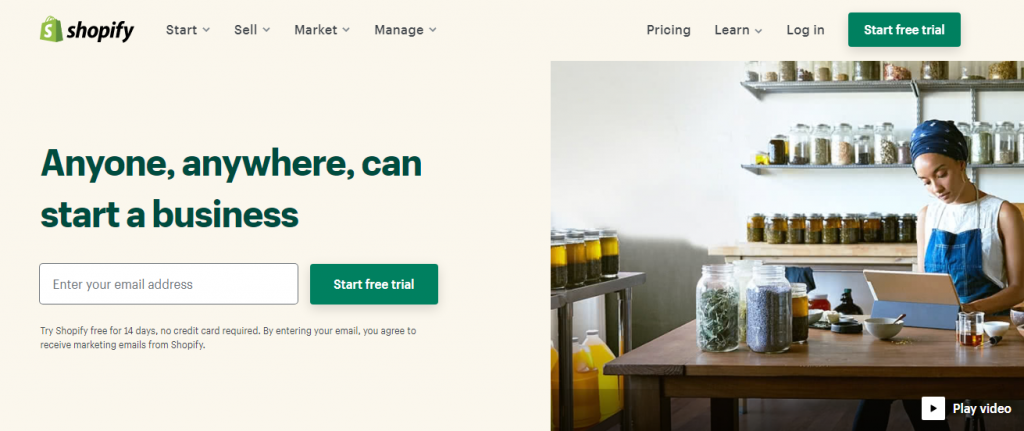
One of the most popular ecommerce platforms, Shopify provides a convenient SaaS solution for business newbies. A merchant doesn’t need much technical knowledge to set up a store and shouldn’t be a professional designer to install a theme from a 60+ offerings on the official Shopify marketplace. The solution also comes with a free SSL certificate, 24/7 support, and 70+ integrated payment methods.
Pricing: Shopify is a subscription ecommerce platform that offers a 14-day trial period followed by a $29 monthly fee for a Basic Shopify package.
Pros & Cons of Shopify:
+ Easy-to-use intuitive interface to publish content, including products, descriptions, images, etc.
+ An SSL certificate and hosting included in the price.
+ Large marketplace of apps, themes, and plugins.
+ The ability to add an unlimited number of SKUs and create 100 variants of a single product.
+ Cross-channel ecommerce: an admin can add multiple sales channels, like Facebook, Instagram, Amazon, etc. and sell in multiple currencies.
+ Built-in function to set different shipping rates (free, flat, price-based, weight-based, calculated rates).
+ Built-in email marketing tools and basic analytics.
+ Free trial and 24/7 support.
— Limited customization: since the platform is not open source, it is challenging to implement any business-specific custom solutions requiring access to the product core code.
— Extra transaction fees if a third-party payment system is integrated.
— Additional expenses for extensions or plug-ins: beware of budget overruns if you need to extend the functionality of your store way too much.
OpenCart
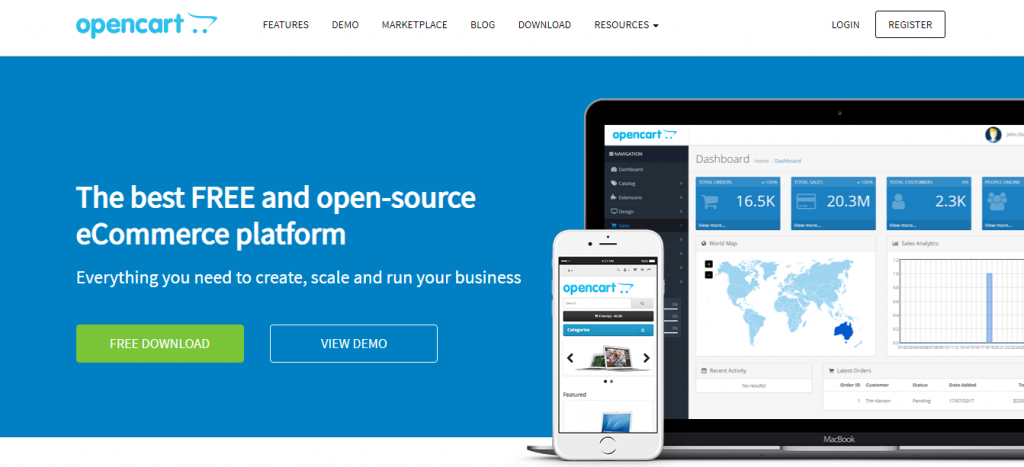
OpenCart is a free open-source ecommerce platform — and there you have two benefits right away! Typically, merchants download it for free and extend the functionalities with pre-built plug-ins and modules. Manual customization is also possible if you have some programming knowledge. OpenCart requires low startup costs and may be a perfect fit for those brands that have already started selling but are still looking for the unique look and feel of the website.
Pricing: OpenCart is free to download, but you should account for additional hosting, web development, and maintenance expenses.
Pros & Cons of OpenCart:
+ Open-source, meaning anyone can modify the code to experiment with the store’s interface and functionalities.
+ Basic sets of commerce features to run a store and 36 integrated payment gateways available out of the box.
+ Plenty of integrations and a large marketplace of 13,000+ themes, plugins, modules, and extensions.
+ Unlimited number of products and categories to be added.
+ Free to download
— Hard to set up: non-techy merchants will surely need to hire a developer to implement their solution.
— Self-hosted: you’ll need to configure servers yourself or find a Magento hosting provider to do it for you.
— Difficult to scale: the increasing number of added modules will slow down your store and may result in budget overruns.
WooCommerce
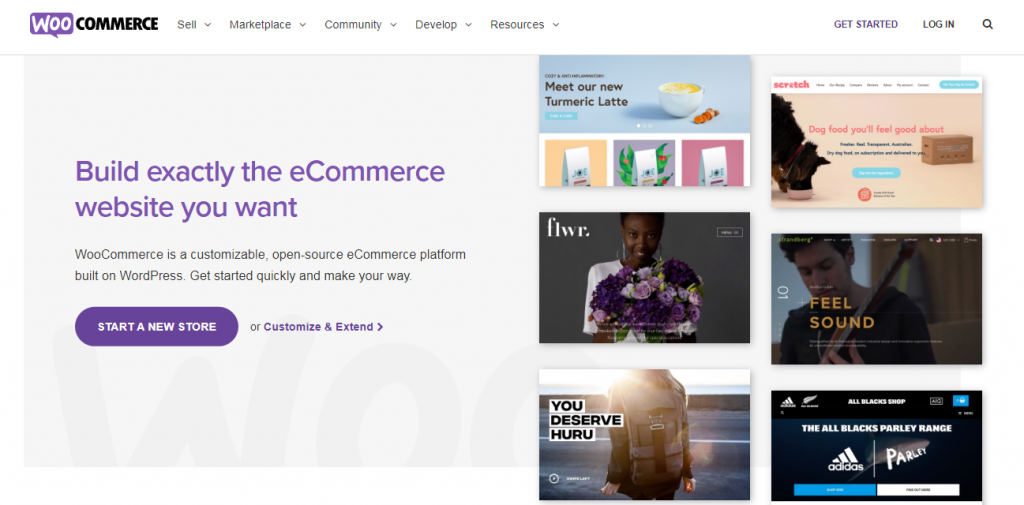
From blogs to stores! WooCommerce is a WordPress plug-in with open-source modifiable code that can turn any website into a store. According to Statista, WooCommerce takes the largest share of the market for its easy use and setup. Frequent use of the platform doesn’t mean it’s fit for all, though: only small stores seeking basic commerce functions will benefit the most from this solution.
Pricing: WooCommerce plugin comes free of charge, but you’ll need to deal with the hosting and maintenance costs.
Pros & Cons of WooCommerce:
+ Easy to start selling with thanks to a fast setup and an intuitive admin interface.
+ A large marketplace of 55,000+ extensions, themes, and plugins and the freedom to customize.
+ No transaction fees and easy integration with some renowned payment gateways, like PayPal, Stripe, and Square.
+ Basic SEO and marketing features.
+ Free core software and an enormous community of developers writing informative articles and documentation.
— Challenging to scale: WooCommerce has weak database architecture for high order volume and traffic, so the website will experience performance issues once the business starts growing.
— A limited set of features set out of the box, which means you’ll have to spend extra on extensions and modules.
— Subject to security issues: because WooCommerce is not a SaaS ecommerce platform, you’ll need to source a PCI certificate, set up PCI-DSS compliance, and upgrade security patches all by yourself.
Ecommerce Platforms for Mid-Size Market
Now, mid-size businesses present different requirements for ecommerce platforms. Because they have grown far past the level of small businesses, mid-size brands realize the importance of scalability and customization. They may have a small but decent catalog of products, generate stable annual revenue between $10 million and $1 billion, and experience medium-load traffic.
Here are a few best ecommerce platforms for mid-size businesses that we recommend.
Magento Open Source

Magento Open Source is one of the affordable Magento editions offering basic commerce functionalities and free core code. Unlike other open-source ecommerce platforms, it offers endless customization opportunities and promising scalability options (case in point: Carbon38 that grew into a sports apparel and fashion giant purely on Magento Open Source). It’s also more affordable than other enterprise ecommerce solutions and flexible in terms of third-party integrations.
Pricing: Magento Open Source can be downloaded for free from the official Magento website. However, hosting, themes, extensions, and Magento development services for that matter should be paid separately.
Pros & Cons of Magento Open Source:
+ Scalable and easy-to-customize.
+ A decent set of features to run a mid-size store, like catalog management; marketing, promotions and conversion tools; global shipping, etc.
+ A large community of users and extensive documentation on the platform use.
+ A responsive and mobile-friendly platform.
+ A free core product.
— Difficult to install: unless you have much technical knowledge, you may need to delegate this setup job to Magento-certified professionals (like Elogic, for instance).
— Self-hosted: you’ll need to take care of your server configuration, security certificates, and possibly maintenance procedures to ensure your website runs smoothly.
— Time-consuming: because Magento is a layered software requiring complex coding, you can’t expect to go live in a few days like with other SaaS ecommerce platforms.
BigCommerce

One of the strongest players in an ecommerce game these days, BigCommerce is a SaaS subscription-based platform. In a battle of BigCommerce vs Magento, it stands out as a great fit for small businesses as it allows a merchant to build and launch a store in a matter of days. But because the platform can accommodate up to 600 variations per product and has many built-in sales features, we’ve placed BigCommerce among the mid-size business solutions.
Pricing: After a 15-day trial, a merchant will have to pay a minimum monthly fee of $29.95. Paying all the annual fees upfront will result in a 10% discount.
Pros & Cons of BigCommerce:
+ Extensive number of built-in features, like ratings and reviews or real-time shipping quotes, which reduces the total cost of ownership (TCO) of the website.
+ Unlimited products, file storage and bandwidth.
+ No transaction fees and 55+ integrated payment gateways
+ Cloud hosting, level 1 PCI certification, and ISO/IEC 27001 compliance for the encryption of financial transactions.
— Limited design options: compared with Shopify or Magento, BigCommerce offers only 7 free and 50 paid themes to its merchants.
— Small app marketplace: BigCommerce heavily relies on its built-in features and has not offered any add-ons until recently.
— Expensive for successful customers: your subscription plan will change once your company crosses the defined threshold of annual revenue.
Drupal Commerce
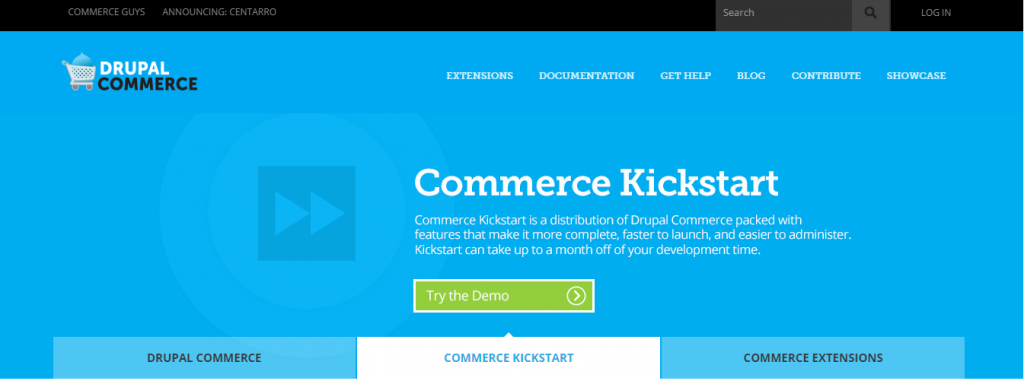
Drupal Commerce is a relatively new open-source ecommerce platform that extends the functionalities of Drupal as a content management system (CMS). Unlike WooCommerce that acts merely as a plugin to WordPress, Drupal Commerce has a much broader set of functionalities and can be integrated with another platform into a headless approach (see Drupal Commerce vs Magento 2 article for more details). Drupal will work best for selling non-standard digital products, like content and books, and has all functionalities to satisfy the needs of a mid-size business.
Pricing: The core software code can be downloaded for free. But a merchant should keep in mind the expenses for hiring a team of web developers to design and implement the website and its components.
Pros & Cons of Drupal Commerce:
+ Built-in features to sell content as a service.
+ Advanced multilingual capabilities: about 100 languages are integrated in a platform out of the box.
+ Marketing automation tools, including real-time sales alerts, advanced email reporting for specific audiences.
+ Large marketplace of 40,000+ extensions, modules, and plugins, most of which are free.
+ Easy integration with 114 payment methods via modules.
+ A big developer community delivering comprehensive documentation.
+ Scalable and secure.
— High learning curve: Drupal requires a decent knowledge of PHP to configure and launch a store, so you won’t be able to set it up alone.
— A lot of custom work: flexibility of Drupal Commerce comes with a lot of coding, so every small module or insignificant upgrade may result in loads of work for your programmers.
— Perfect for selling complex, heavy content but not physical products: Drupal Commerce is missing certain product attributes and focuses mainly on content creation tools.
Best Ecommerce Platforms for Enterprises
Large enterprises are those big sharks in the sea of ecommerce opportunities. They can boast of a consistently high annual turnover, specialized staffed departments for different business operations, and a large number of customers. The technology powering such e-stores should, thus, be customizable, sustain large SKU catalog and traffic spikes, and integrate third-party systems without affecting performance.
How to choose the best ecommerce platform if you’re playing on the high-end of the market? Here are a few platforms to consider.
Magento Commerce [Cloud & On-Premise]

An undeniable leader among the ecommerce platforms, Magento Commerce comes with a wide range of native features suitable for big ecommerce players. In addition to everything Magento Open Source offers, Magento Commerce presents a B2B module, upgraded page builders, and all the merchandising capabilities a business may need. It comes in two hosting solutions — on-premise and cloud — the latter being another advanced edition of the platform called Magento Commerce Cloud.
Pricing: The license fees start at $24,000 per year for Magento Commerce and at $40,000 per year for Magento Commerce Cloud.
Pros & Cons of Magento Commerce:
+ A vast set of out-of-the-box features, which makes a merchant save money on developing custom modules and functionalities.
+ Flexible and customizable in terms of web development (unlike its major enterprise Shopify Plus competitor).
+ Easy integration with many third-party systems to build API-led ecommerce architecture.
+ Advanced analytics and reporting thanks to Magento Business Intelligence (BI).
+ Integrated B2B module.
+ Scalability and security.
+ 24/7 technical support and a large community of certified developers.
+ Cloud hosting, enhanced security, and optimized performance on Magento Commerce Cloud.
— High total cost of ownership: in addition to the license fees, a merchant should account for maintenance and custom feature development overheads.
— A time-consuming solution: because Magento is a layered software, it might take some time before your store gets up and running.
commercetools

2020 Gartner Magic Quadrant for Digital Commerce has recently dropped a bombshell on ecommerce players having introduced commercetools as a new leader in the industry. Indeed, commercetools is a relatively new platform but has already won trust of large enterprises, like Tiffany or Audi. Its MACH technology (Microservices, API-First, Cloud Native, and Headless) is everything a large store with complex architecture is looking for in a SaaS ecommerce platform.
Pricing: The vendor doesn’t specify the license fees, but provides a 60-day trial. Other web design and development expenses will depend on the scope of work.
Pros & Cons of commercetools:
+Microservice architecture that allows for quick integration of new services, customization of customers’ experience, and fast upscaling.
+API-first solution that helps to deliver omnichannel experience by building Progressive Web Apps (PWAs), iOS and Android native apps, and digital marketplaces.
+ Scalable infrastructure thanks to cloud hosting.
+ Headless ecommerce platform.
+ Security, speed, and agility.
— Unclear total cost of ownership: because the vendor doesn’t specify any fees, it may be hard to allocate an accurate budget for the project.
— Digital maturity: a commercetools solution suits only technically innovative clients ready for complex system integrations and experiments.
Salesforce Commerce Cloud
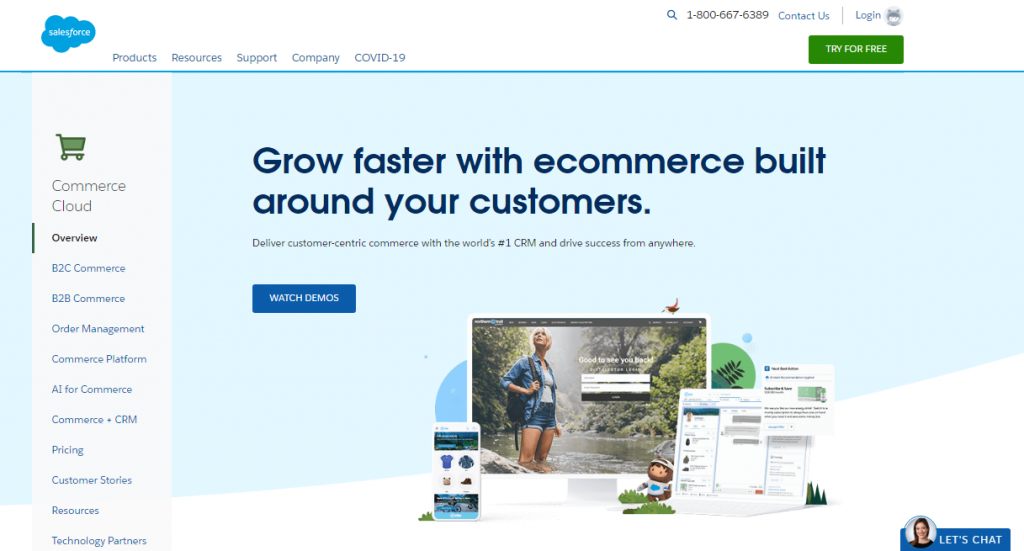
Salesforce is a company with a long history of software development. It initially placed a particular focus on CRMs until 2016 when the company acquired Demandware. Since then, Salesforce has become one of the most trusted cloud SaaS ecommerce platforms that allows for quick and stable business growth around your customers. Large enterprises adore the platform for its scalability, flexibility, and — most importantly — stability no matter the sales season and/or traffic.
Pricing: The vendor is fairly reserved about their fees but surely follows a shared success pricing model: the more you earn, the higher the price of a Salesforce package.
Pros & Cons of Salesforce Commerce Cloud:
+Easy-to-navigate admin panel and customizable dashboards.
+Cloud hosting that makes a solution highly scalable.
+ Reliable security upgrades.
+ Easy integration with third-party systems, especially with Salesforce native CRM and AI-based marketing tools.
+ Multiple languages, multiple currency checkout, and localized payment methods.
— High total cost of ownership: expanding data and storage limits, adding new features, hiring a maintenance team are all implicit costs related to a solution.
— Weak technical assistance: Salesforce is quite notorious for its technical support as it may take days to reach them; many merchants hire third-party companies to address store-related issues.
— Red tape involved in the customization process: you should receive Salesforce approval before implementing a custom solution, so this platform is less agile than other software in this category.
Which Ecommerce Platform Should I Use? Things to Consider
By now, you must be overwhelmed with market propositions and wonder which ecommerce platform to choose out of all this scramble of offerings? Don’t give in! Here are the selection criteria you should definitely take into account while making a decision:
- The size and maturity of your business: if you’re running a small store, why not try a free open-source platform like Magento first and then switch to a bigger one.
- Your business model: there’s no point in choosing a solution with advanced B2B functionality if you’re running a B2C or D2C business.
- Your current and future needs: if you’re looking to expand in the nearest future, go for a platform that allows painless and smooth upscaling.
- Your budget: don’t underestimate website maintenance and support costs after its initial development.
Sit down at the negotiation table with each vendor that interests you, articulate your requirements, and see what they have to offer. Choosing the best ecommerce platform may not be the decision of a lifetime but it definitely determines the direction and speed of your business growth.

